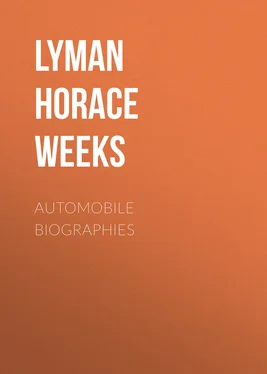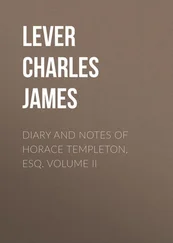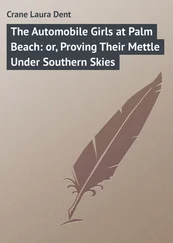Lyman Horace Weeks - Automobile Biographies
Здесь есть возможность читать онлайн «Lyman Horace Weeks - Automobile Biographies» — ознакомительный отрывок электронной книги совершенно бесплатно, а после прочтения отрывка купить полную версию. В некоторых случаях можно слушать аудио, скачать через торрент в формате fb2 и присутствует краткое содержание. Жанр: Биографии и Мемуары, auto_regulations, foreign_antique, на английском языке. Описание произведения, (предисловие) а так же отзывы посетителей доступны на портале библиотеки ЛибКат.
- Название:Automobile Biographies
- Автор:
- Жанр:
- Год:неизвестен
- ISBN:нет данных
- Рейтинг книги:5 / 5. Голосов: 1
-
Избранное:Добавить в избранное
- Отзывы:
-
Ваша оценка:
- 100
- 1
- 2
- 3
- 4
- 5
Automobile Biographies: краткое содержание, описание и аннотация
Предлагаем к чтению аннотацию, описание, краткое содержание или предисловие (зависит от того, что написал сам автор книги «Automobile Biographies»). Если вы не нашли необходимую информацию о книге — напишите в комментариях, мы постараемся отыскать её.
Automobile Biographies — читать онлайн ознакомительный отрывок
Ниже представлен текст книги, разбитый по страницам. Система сохранения места последней прочитанной страницы, позволяет с удобством читать онлайн бесплатно книгу «Automobile Biographies», без необходимости каждый раз заново искать на чём Вы остановились. Поставьте закладку, и сможете в любой момент перейти на страницу, на которой закончили чтение.
Интервал:
Закладка:
But Murdock was too useful a man to Boulton & Watt to be allowed to have free rein, and his inclination toward steam locomotion invention was apparently curbed, though it would appear Watt thought the roads of that time an insurmountable obstacle to the development of road vehicles, and wanted Murdock to devote his time to mechanical matters more ripe for success. Boulton, writing to Watt from Truro, in September, 1796, tells how he met Murdock on his way to London to get a patent on a new model, and how he persuaded him to turn back. This model was for a steam carriage that was afterward shown as able to travel freely around a room with a light load of shovel, poker and tongs upon it. His was probably the first high-pressure steam-engine vehicle run in England. Though only a small model, it did its proportionate work well.
Watt continued to oppose Murdock’s scheme, but on one occasion suggested that he should be allowed an advance of five hundred dollars to enable him to prosecute his experiments, and if he succeeded within a year in making an engine capable of drawing a post chaise, carrying two passengers and the driver, at four miles an hour, it was suggested that he should be taken as partner into the locomotive business, for which Boulton and Watt were to provide the necessary capital. This proposition was never carried out. Again, in 1786, Watt said: “I wish William could be brought to do as we do, to mind the business in hand, and let such as Symington and Sadler throw away their time and money in hunting shadows.” Murdock continued to speculate about steam locomotion on common roads, but never carried his ideas further. He retired from the employment of Boulton & Watt in 1830, and practically retired from all work at the same time.
Murdock seems to have had a very clear idea of the possibilities of steam propulsion on the common roads. Had circumstances permitted he might well have been expected to have solved the problem in 1796 quite as completely as his successors did in 1835. But he was a quarter of a century ahead of the time. Even the moderate public interest that existed later on had not manifested itself at all in his day and the condition of the English highways offered almost insuperable obstacles to steam vehicular travel. Personally his lack of self-assertiveness and his feeling of dependence upon Boulton and Watt also held him back. So he remained simply one of the pioneer investigators pointing the way for others.
Born in 1755 or 1756, in Newport, Del. Died in Philadelphia, April 21, 1819.
Little has been preserved respecting the early history of Oliver Evans, who has been aptly styled “The Watt of America.” His parents were farming people, and he had only an ordinary common-school education. At the age of fourteen he was apprenticed to a wheelwright or wagonmaker, and continued his meager education by studying at night time by the light that he made by burning chips and shavings in the fireplace.
While yet an apprentice his attention was turned to the subject of propelling land carriages without animal power. But the lack of definite knowledge in regard to steam power compelled him to abandon his plans, although his experiments were continued for a long time. Soon after attaining his majority he was engaged in making card-teeth by hand, and in connection therewith developed several labor-saving improvements. He also invented improvements in the construction of machinery of flour mills that effected a complete revolution in the manufacture of flour. These improvements consisted of the elevator, the conveyor, the hopper-boy, the drill and the descender, which various machines were applied in different mills so as to perform mechanically every necessary movement of the grain and meal from one part of the mill to the other, causing a saving of fully one-half in the labor of mill attendance and manufacturing the flour better. These improvements were not accepted by the mill owners at the outset, and Evans spent many discouraging years before he could finally persuade the manufacturers of the utility of his inventions. In the end, however, he lived to see his inventions generally introduced, and he profited largely thereby.
In the year 1786, Evans petitioned the Legislature of Pennsylvania for the exclusive right to use his improvements in flour mills and steam carriages in that State, and in the year following presented a similar petition to the Legislature of Maryland. In the former instance he was only successful so far as to obtain the privilege of the mill improvements, his representations concerning steam carriages being considered as savoring too much of insanity to deserve notice. He was more fortunate in Maryland, for, although the steam project was laughed at, yet one of his friends, a member, very judiciously observed that the grant could injure no one, for he did not think that any man in the world had thought of such a thing before, and therefore he wished the encouragement might be afforded, as there was a prospect that it would produce something useful. This kind of argument had its effect, and Evans received all that he asked for, and from that period considered himself bound in honor to the State of Maryland to produce a steam carriage, as soon as his means would allow him.
For several years succeeding the granting of his petition by the Legislature of Maryland, Evans endeavored to obtain some person of pecuniary resources to join with him in his plans; and for this purpose explained his views by drafts, and otherwise, to some of the first mechanics in the country. Although the persons addressed appeared, in several instances, to understand them, they declined any assistance from a fear of the expense and difficulty of their execution.
In the year 1800, or 1801, Evans, never having found anyone willing to contribute to the expense, or even to encourage him in his efforts, determined to construct a steam carriage at his own expense. Previous to commencing he explained his views to Robert Patterson, Professor of Mathematics in the University of Pennsylvania, and to an eminent English engineer. They both declared the principles new to them, and advised the plan as highly worthy of a fair experiment. They were the only persons who had any confidence, or afforded encouraging advice. He also communicated his plans to B. F. Latrobe, the scientist, who publicly pronounced them as chimerical, and attempted to demonstrate the absurdity of Evans’ principles in his report to the Philosophical Society of Pennsylvania on steam engines. In this he also endeavored to show the impossibility of making steamboats useful.
Evans commenced and had made considerable progress in the construction of a steam carriage, when the idea occurred to him that as his steam engine was altogether different in form, as well as in principle, from any other in use, a patent could be obtained for it, and then applied to mills more profitably than to carriages. The steam carriage was accordingly laid aside for a season of more leisure, and the construction of a small engine was commenced, with a cylinder six inches in diameter and a piston of eighteen inches stroke, for a mill to grind plaster of paris. The expense of its construction far exceeded Evans’ calculation, and before the engine was finished he found it cost him all he was worth. He had then to begin the world anew, at the age of forty-eight, with a large family to support, and that, too, with a knowledge that if the trial failed his credit would be entirely ruined, and his prospects for the remainder of life dark and gloomy. But fortune favored him, and his success was complete.
In a brief account, given by himself, of his experiments in steam, he says: “I could break and grind three hundred bushels of plaster of paris, or twelve tons, in twenty-four hours; and to show its operations more fully to the public, I applied it to saw stone, on the side of Market Street, where the driving of twelve saws in heavy frames, sawing at the rate of one hundred feet of marble in twelve hours, made a great show and excited much attention. I thought this was sufficient to convince the thousands of spectators of the utility of my discovery, but I frequently heard them inquire if the power could be applied to saw timber as well as stone, to grind grain, propel boats, etc., and though I answered in the affirmative, they still doubted. I therefore determined to apply my engine to all new uses; to introduce it and them to the public. This experiment completely tested the correctness of my principles. The power of my engine rises in a geometrical proportion, while the consumption of the fuel has only an arithmetical ratio; in such proportion that every time I added one-fourth more to the consumption of the fuel, its powers were doubled; and that twice the quantity of fuel required to drive one saw, would drive sixteen saws at least; for when I drove two saws the consumption was eight bushels of coal in twelve hours, but when twelve saws were driven, the consumption was not more than ten bushels, so that the more we resist the steam, the greater is the effect of the engine. On these principles very light but powerful engines can be made suitable for propelling boats and land carriages without the great encumbrance of their weight as mentioned in Latrobe’s demonstration.”
Читать дальшеИнтервал:
Закладка:
Похожие книги на «Automobile Biographies»
Представляем Вашему вниманию похожие книги на «Automobile Biographies» списком для выбора. Мы отобрали схожую по названию и смыслу литературу в надежде предоставить читателям больше вариантов отыскать новые, интересные, ещё непрочитанные произведения.
Обсуждение, отзывы о книге «Automobile Biographies» и просто собственные мнения читателей. Оставьте ваши комментарии, напишите, что Вы думаете о произведении, его смысле или главных героях. Укажите что конкретно понравилось, а что нет, и почему Вы так считаете.












